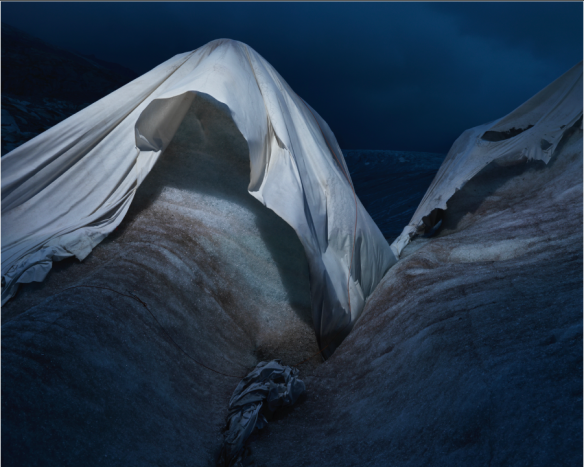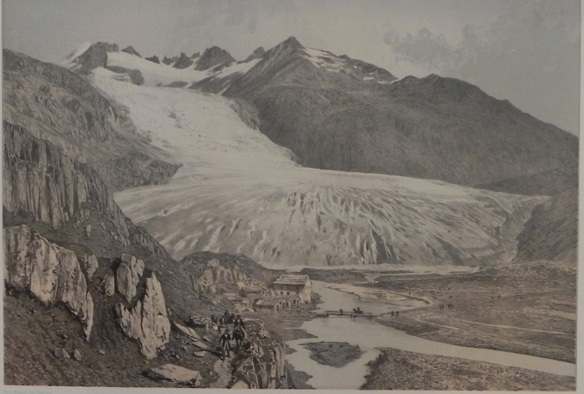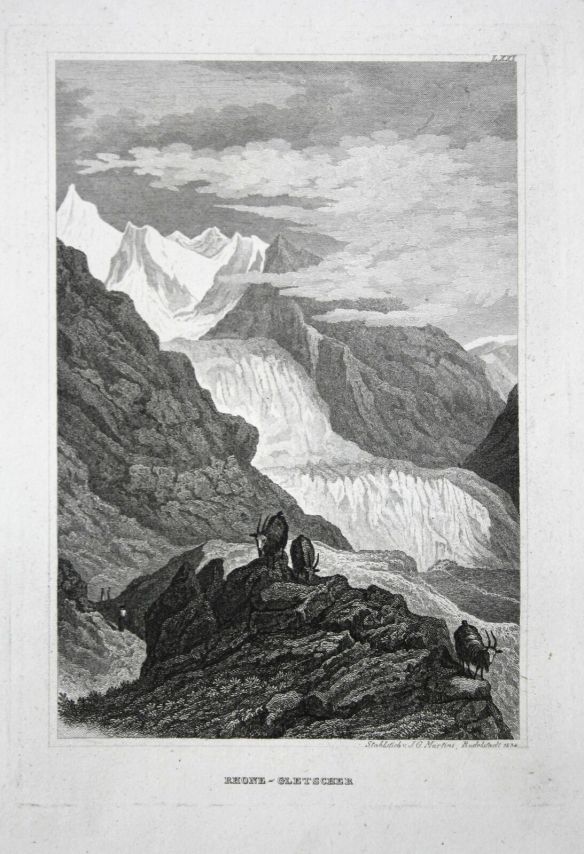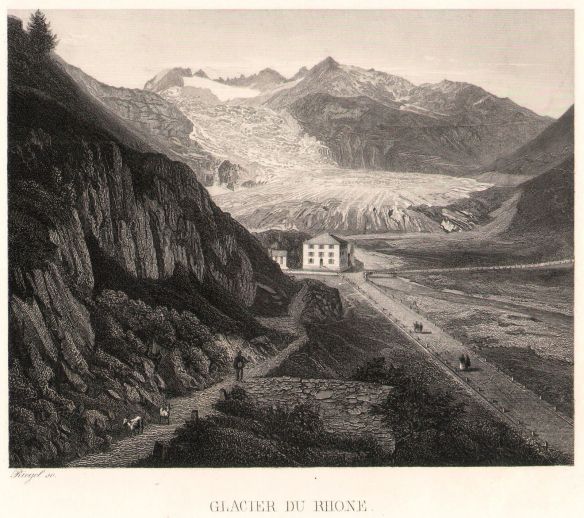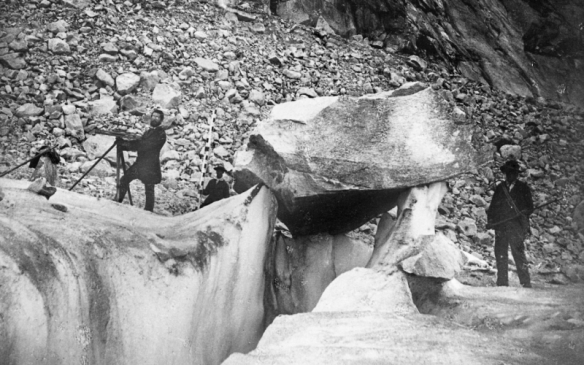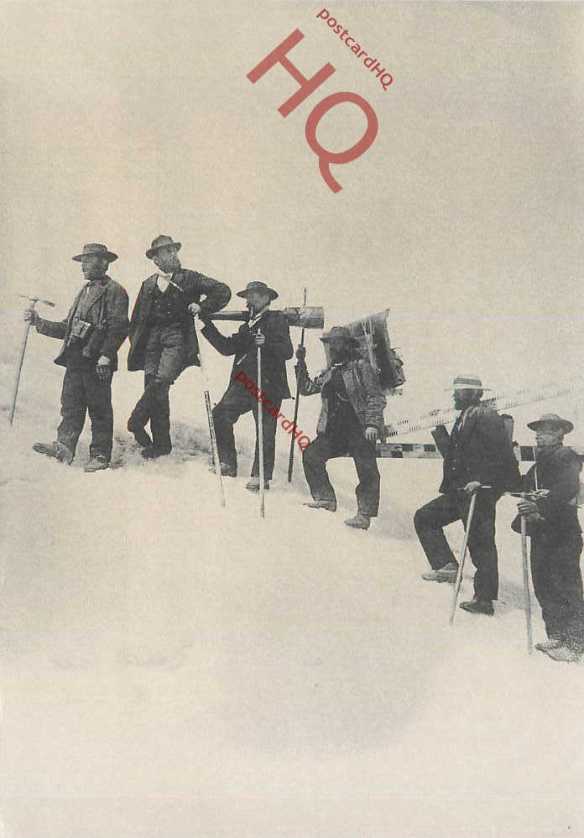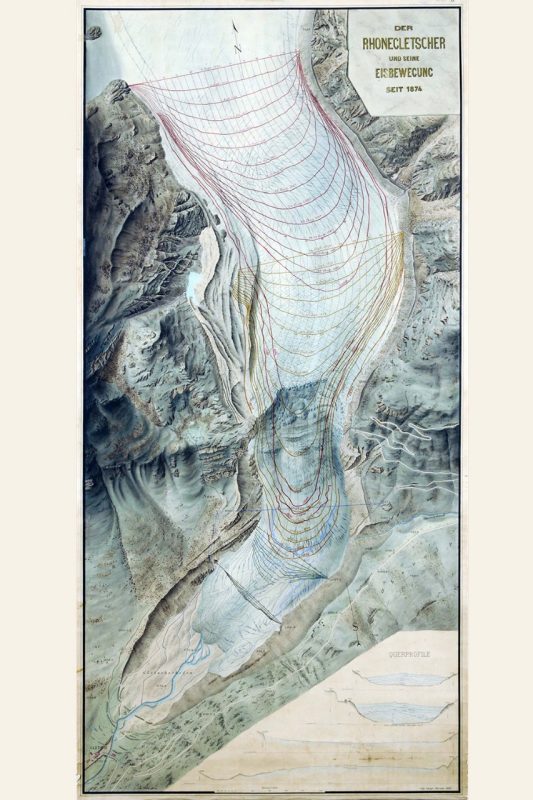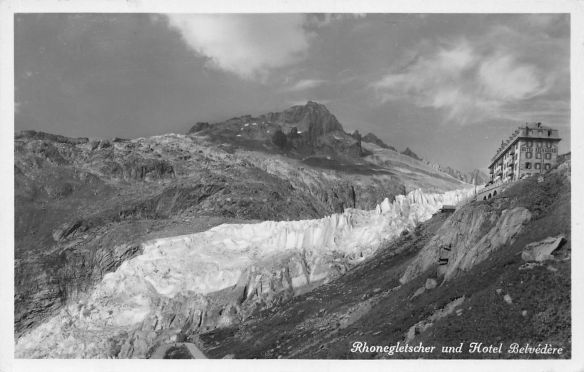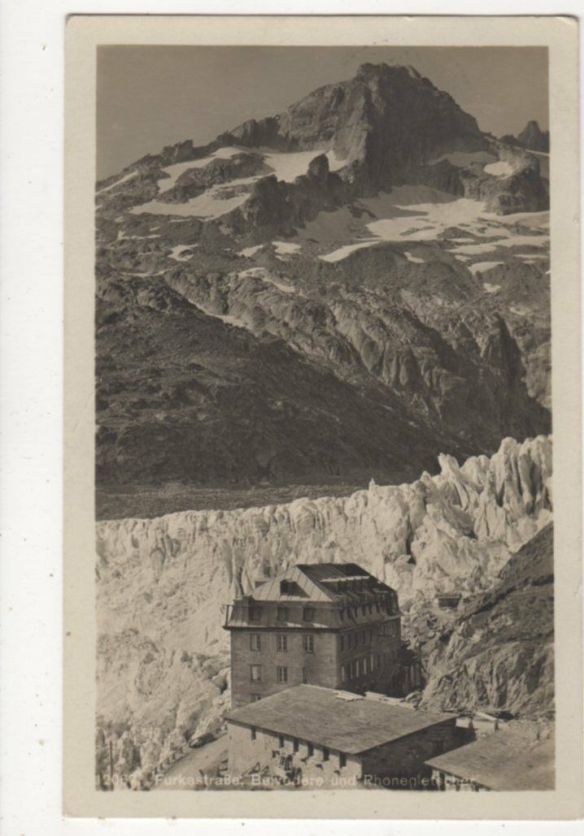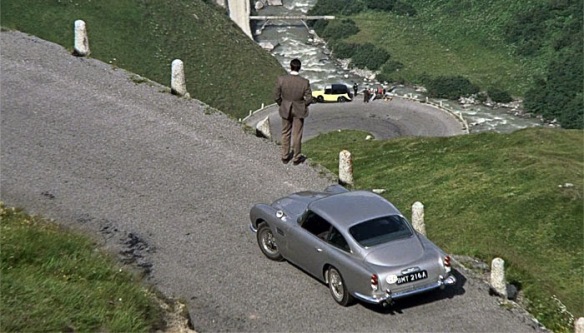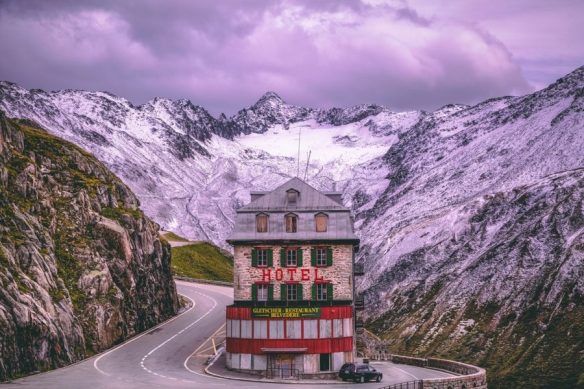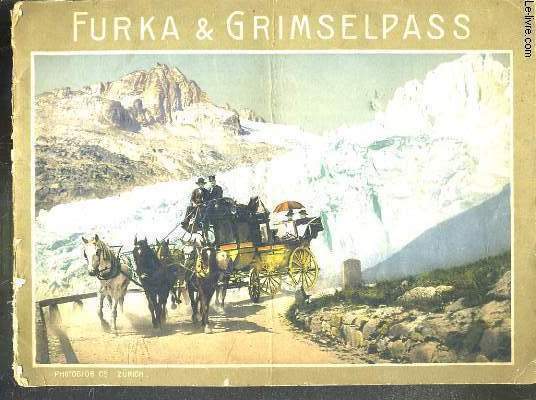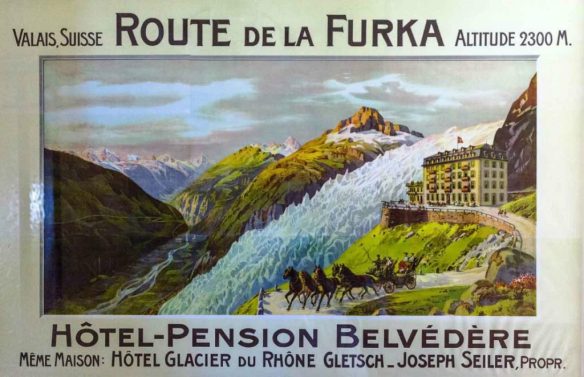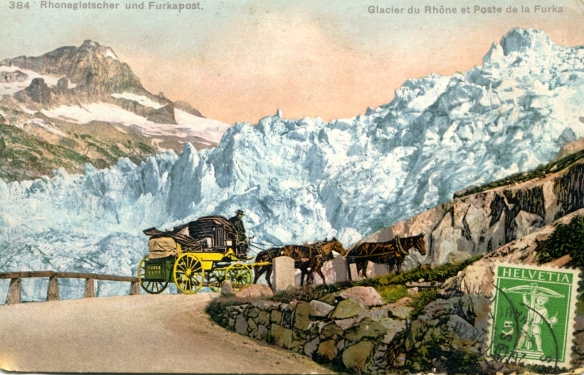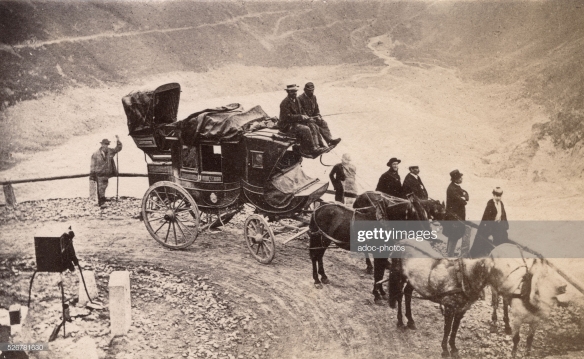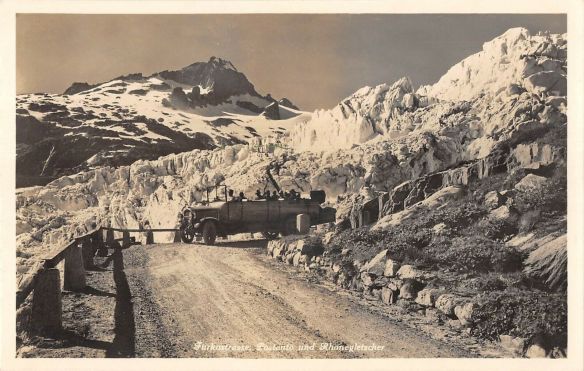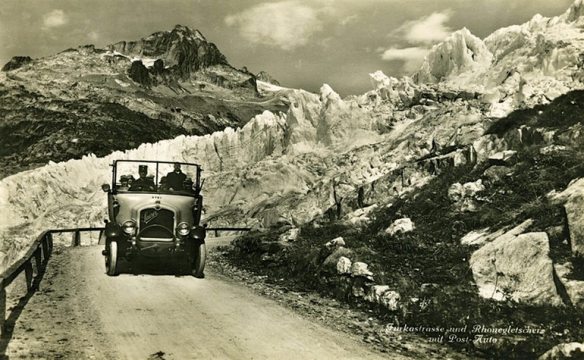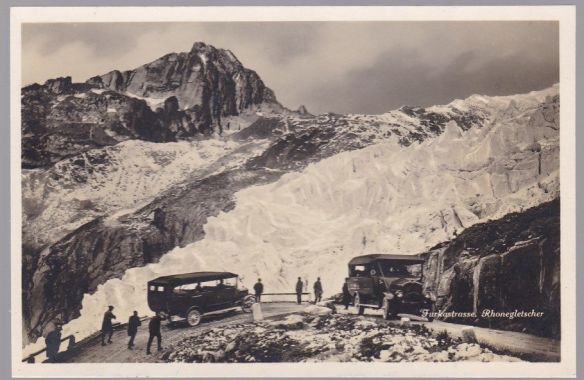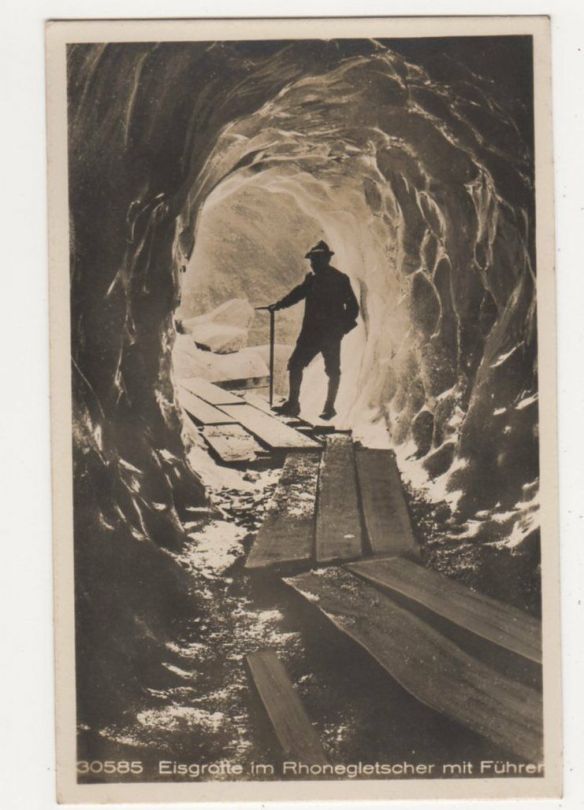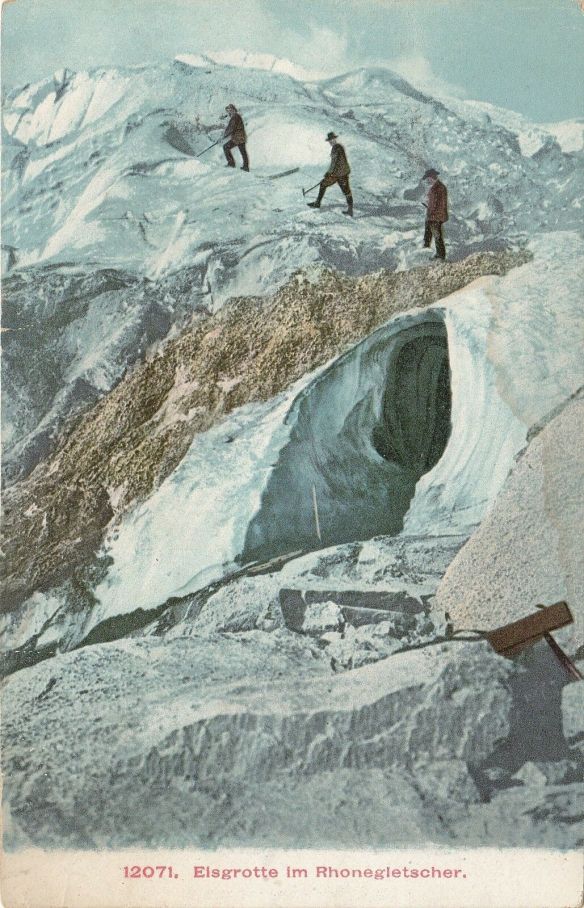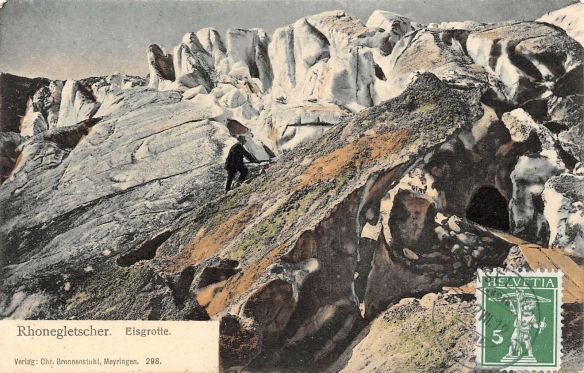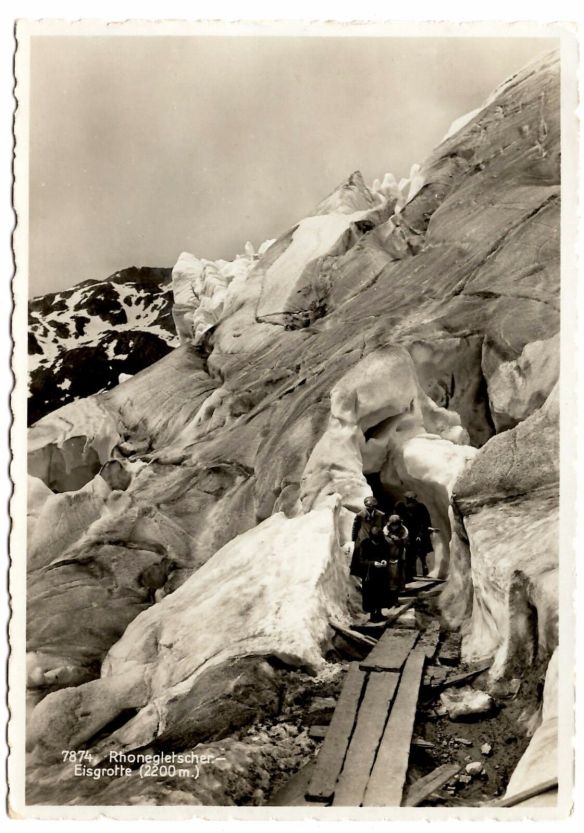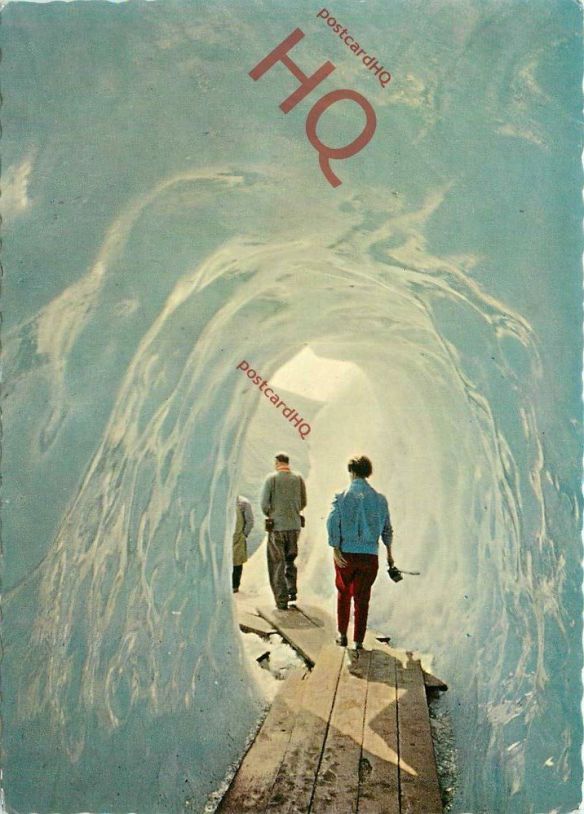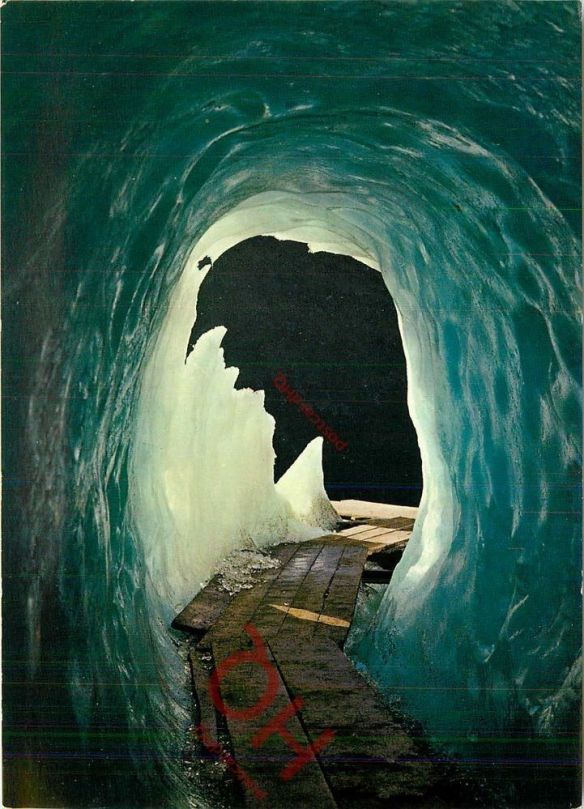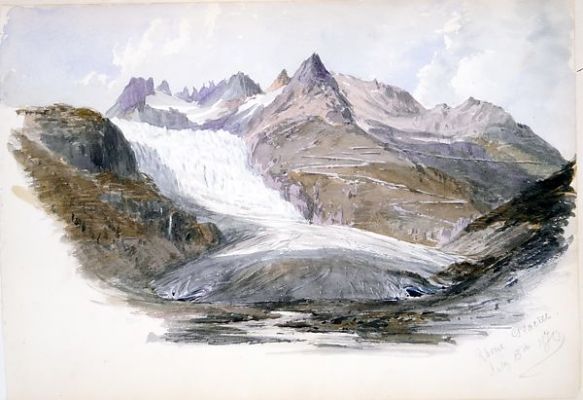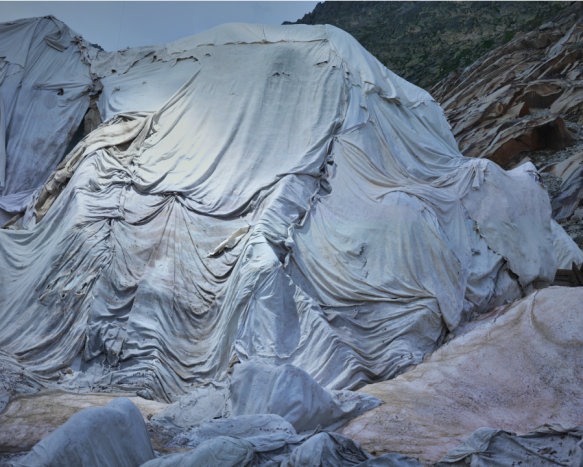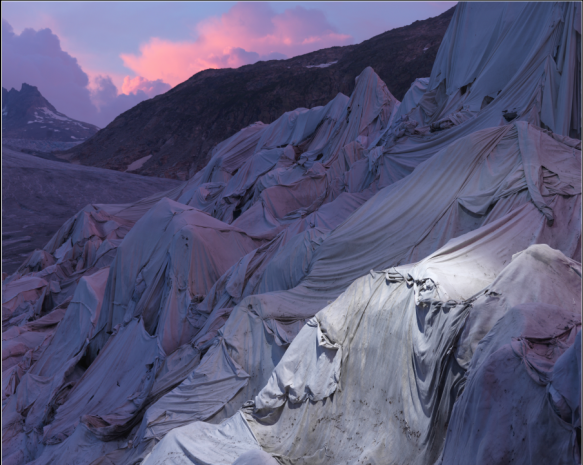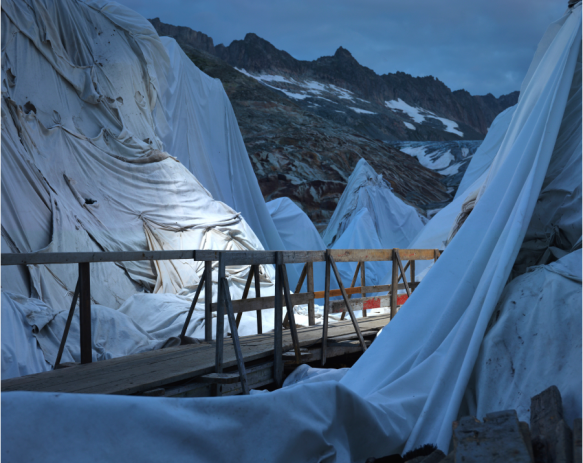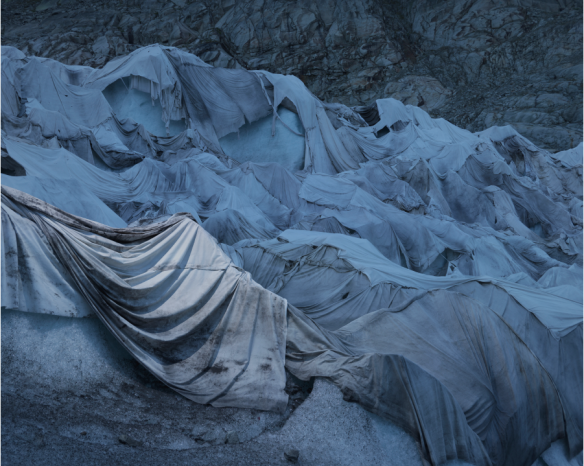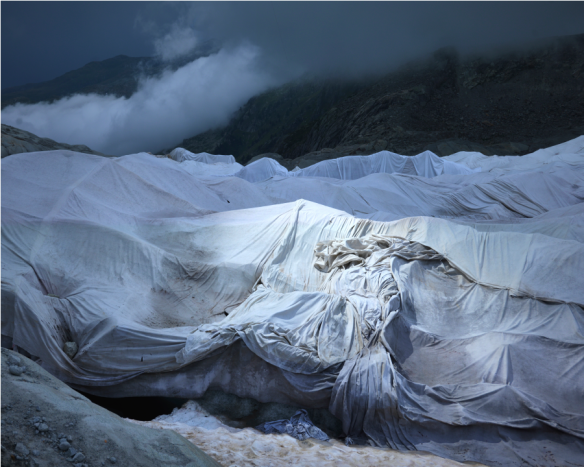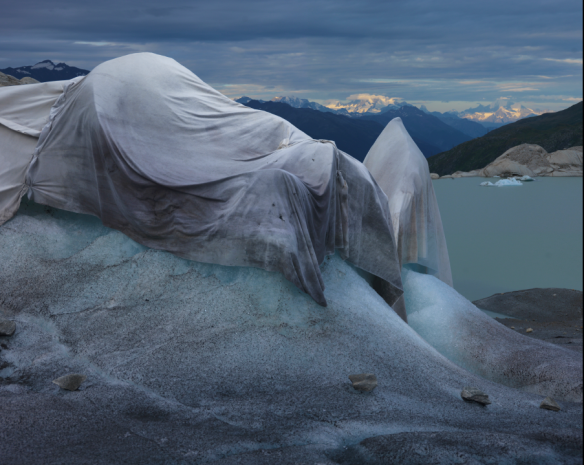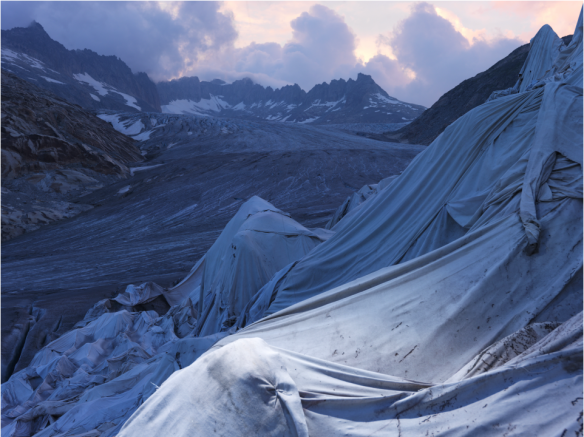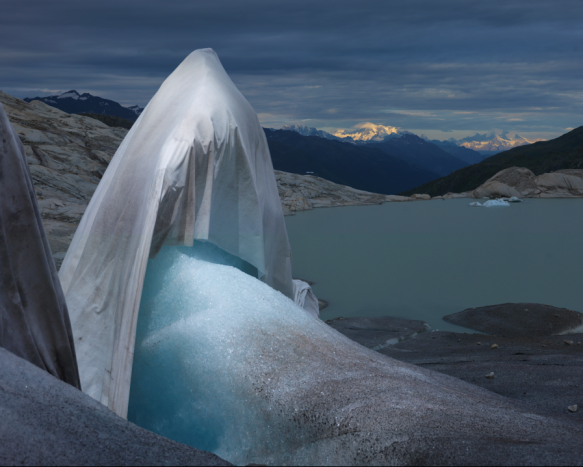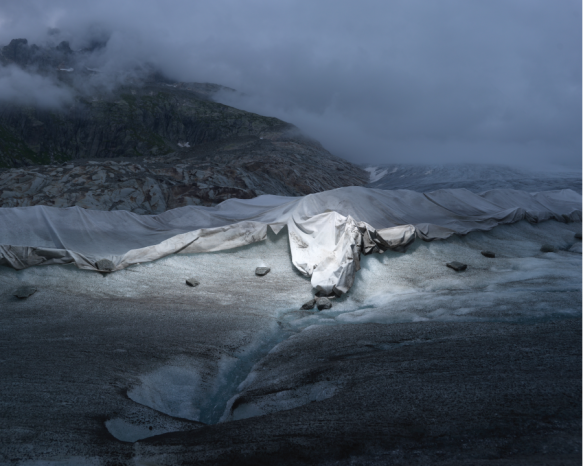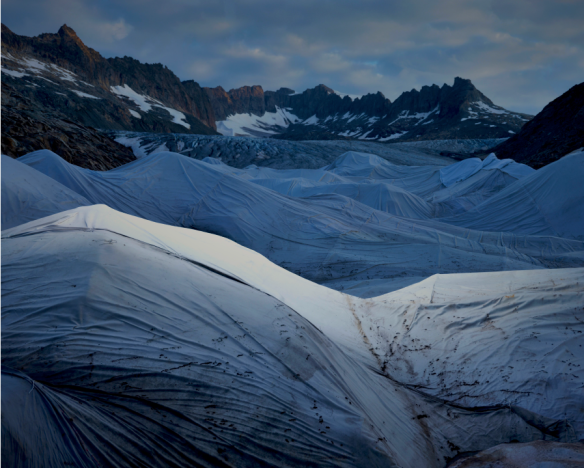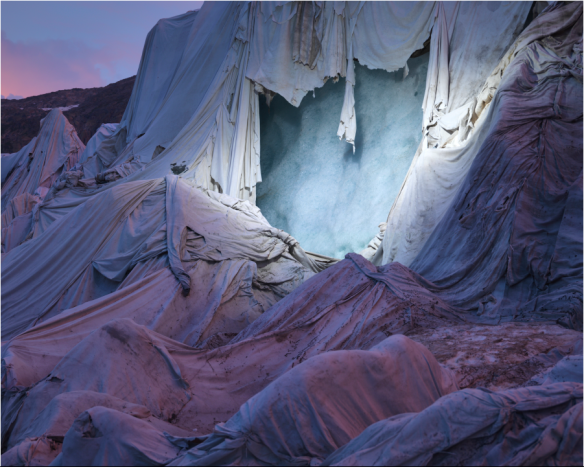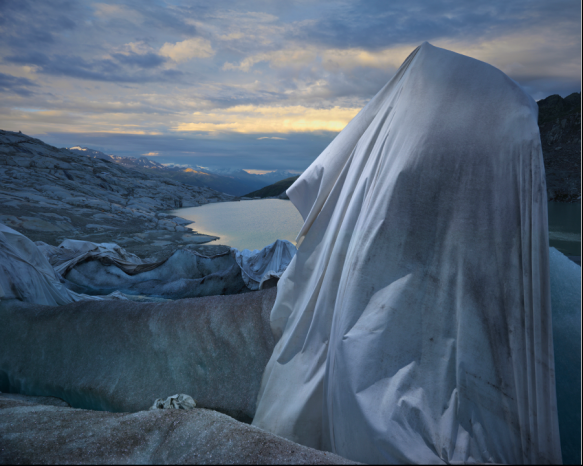The Shroud on the Glacier du Rhône by Klaus Thymann and Simon Norfolk
Every so often I republish here texts which have been earlier seen elsewhere. This is mainly to make some attempt to group my stuff in one place. What follows is an introduction to a moving group of pictures on the death of a glacier in Switzerland. It is a version of the text which appeared online in Granta in April of 2020, republished with thanks to Granta for allowing it.
The French distinguish between a rivière and a fleuve. A fleuve is a mighty river, defined specifically as one which flows into the ocean or the sea. It’s made of lots of rivers joined, and it defines its whole part of the world. The Severn and the Thames and the Trent may just about be fleuves, although English has seen no need of the word. But the Rhône is a fleuve, very much so. The Rhône is only just navigable. It is a great European artery, but not one you mess with. It floods the towns along its course, which changes anyway as the masses of gravelly sediment it rolls down settle and shift.
Historically, upstream movement was impossible in times of high flow. At best it was made by teams of forty horses pulling a load of less than a hundred tons: a month from Arles to Lyon (compared to the two-three days for the same trip downstream). In the mid nineteenth century, an engineer called Claude Verpilleux (he was almost illiterate, but gifted for machines) designed tugs which rolled a pronged wheel along the river bottom, a bit like a funicular railway. Against general scepticism, the system worked and made a huge saving in coal. For nearly 50 years, Verpilleux tugs set the rate for upstream haulage.
Further south, the delta of the Rhône, like the delta of the Danube, is one of the great European geographic zones. It deviated the routes of travellers even before it set the routes of Roman roads. The Rhône valley as a whole defines something of France. The great wind of the valley, the Mistral, said always to blow in multiples of three days, has blown its way into the national character of the Midi, the French south. Madame de Sévigné called the Rhône: “Ce diantre de Rhône, si fier, si orgueilleux, si turbulent.” (That dreadful Rhône, so headstrong, so proud, so troubled.”)
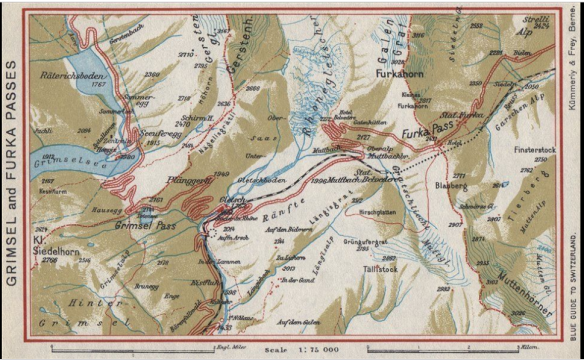
The Rhône Glacier (top centre) as depicted in the Blue Guide for 1948. The Furka Pass with its hairpins is to the right as we look, the Grimsel Pass to the left. The infant Rhône drops out of the frame a little to the left of the bottom centre..
The source of this giant has been a place of great interest for a very long time. It rises from under a glacier – the Rhône Glacier is its unsurprising name – in the Valais, not far from Andermatt, in a region where a number of the highest Alpine passes radiate, and therefore where a number of routes meet. Travellers who wanted to go east or west had to duck under the snout of the glacier before climbing up the Furka pass or the Grimsel pass.
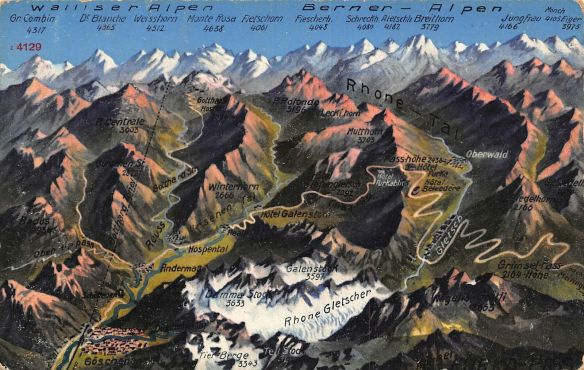
A different perspective showing the Pennine Alps and Bernese Alps. The Rhône Glacier is the white patch in the lower centre, and the Grimsel and Furka passes wiggle up at the right.
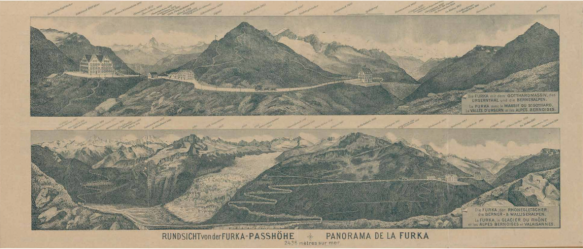
Panorama of the Furka by Armbruster Reinhard from 1890. The Rhône Glacier, as it used to, reaches right down to the valley floor.
This is a continental watershed. According to a Master’s thesis on the Furka region by an architect called Jan de Vylder, who helped restore the Furkablick hotel (even higher than the Belvedere, of which more later) and who recounts an astonishing list of dozens of artists and artworks brought there by its adventurous owner Marc Hostettler in the brief heyday of the Furkart summer art events from 1984, the “pass itself and the summits surrounding it, reaching an elevation of more than 3000m, form the watershed between three major European river systems: the Rhine (of which the Reuss is a tributary) which runs to the North Sea, the Rhône feeding the Mediterranean, and the river Po which connects to the Adriatic sea. A few km to the East is the origin of the river Inn, which is a tributary of the Danube and runs to the Black Sea.”
By being sited so near the passes, the glacier was curiously accessible (all such terms are relative in the high Alps, but still). For many, no doubt, that glacier was just a dreadful obstacle. But for a few, it has been a source of wonder of a particular kind. Partly by its accessibility, the Rhône Glacier was one of the great monuments of the sublime, that peculiarly eighteenth-century sentiment cooked out of equal parts of Enlightenment interest in the natural sciences, romantic laicism and the growing possibilities of travel. As Byron put it, in Childe Harold’s Pilgrimage,
I live not in myself, but I become
Portion of that around me; and to me,
High mountains are a feeling ..
Burke, whose 1756 essay on it is always given as one of the places where British thinking on the sublime was first decoded, quotes Milton describing the landscape that fallen angels must cross:
O’er many a dark and dreary vale
They passed, and many a region dolorous;
O’er many a frozen, many a fiery Alp;
Rocks, caves, lakes, fens, bogs, dens, and shades of death,
A universe of death.
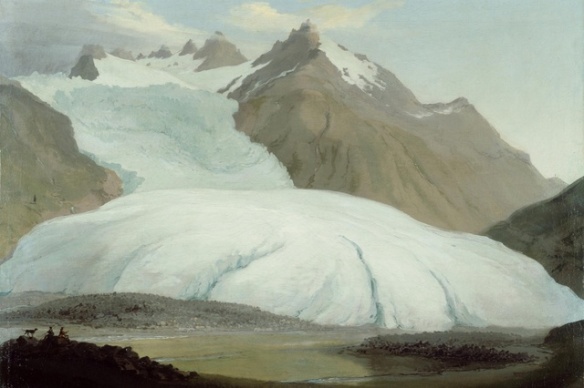
The Rhône Glacier above Gletsch, by Caspar Wolf, 1778. In all these earlier views, the ice is thick right down on the valley floor.
That’s the upper Rhône valley in a nutshell to the eye of eighteenth or nineteenth century travellers. As you craned your neck up to the high peaks and as the sun disappeared over the ridges and dark came early to the valleys; or as you realised that you were above the treeline, and therefore above the familiar landscapes of the lowlands, a sense of awe became the required feeling for visitors. That awe finds expression in language close to that of religion. Here’s Shelley in 1816, writing of the river Arve, that flows through Chamonix in another part of the Alps:
Thus thou, Ravine of Arve—dark, deep Ravine—
Thou many-colour’d, many-voiced vale,
Over whose pines, and crags, and caverns sail
Fast cloud-shadows and sunbeams: awful scene,
Where Power in likeness of the Arve comes down
From the ice-gulfs that gird his secret throne,
Bursting through these dark mountains like the flame
Of lightning through the tempest
That’s not so very far from the language of the Book of Revelation.
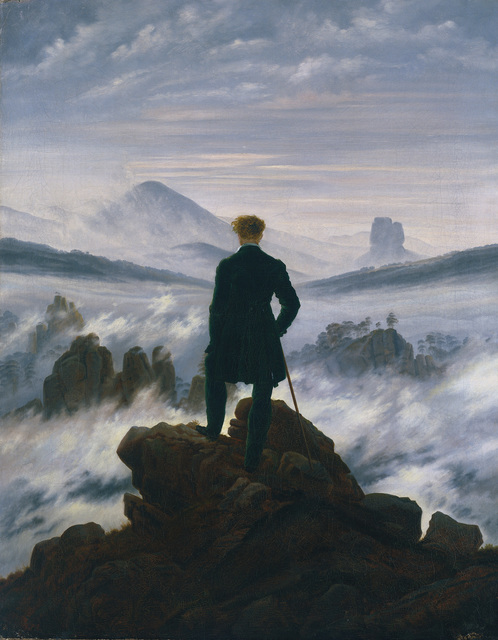
Der Wanderer über dem Nebelmeer (The Wanderer Above the Sea of Mist) by Caspar David Friedrich, c1818
Carlyle – essentially a Romantic, although the historian and essayist that he became easily cloak that – translated Ludwig Tieck’s Der Runenberg (1804), a tale on the wilder shores of the sublime that is both typical and fairly mad. The protagonist, like that of The Pilgrim’s Progress, is called Christian, and his journey is a mystical quest in which lumbermen and so on help him, but the mountains themselves affect his sensibility. Perhaps that’s enough; it allows us to skip all the frankly rather over-elaborate allegorical detail of his expedition into the high mountains. Think of Caspar David Friedrich’s solitary Wanderer, a gentleman in a frock coat, monarch of all he surveyed, staring down from the moderate peak that he simply cannot have scaled hatless and in town boots, to get the simplest impression of what the high mountains came to mean in the Romantic sensibility. And think that if Wordsworth could get a bit exalted about the Golden Valley above Tintern and his beloved Lake District, how much stronger the effect of high Alps might be. Goethe himself was a keen mountaineer, I remember, and with him Faust. Here (in 1833) is the first talking in the voice of the second:
Gazing at those deep solitudes beneath my feet,
I tread the mountain brink with deliberation,
Leaving the cloud-vehicle that carried me,
Softly, through bright day, over land and ocean.
These Romantic generations looked on the Alps and started to think beyond Romance. The mountains spurred them to geology – including the movement of tectonic plates; to climate; and eventually to the impermanence of Man and the ever longer timelines that simply had to be true if fossils could be found at altitude. Humbodlt’s work on Chimborazo certainly partakes of something of the Romantic sensibility to the mountains, for all its unassailable scientific value.
Not everyone got it right. The critic John Ruskin was adamant that the power of glaciers was exaggerated: “A glacier scoops out nothing;” he lectured to the Royal Institution in 1863, “once let it meet with a hollow, it spreads into it, and can no more deepen its receptacle than a custard can deepen a pie-dish… Full in the face of this same Rhône Glacier two impertinent little rocks stood up to challenge it. Don Quixote with his herd of bulls was rational in comparison. But the glacier could make nothing of them. It had to divide, slide, split, shiver itself over them, and ages afterwards, when it had vanished like an autumn vapour from the furrow of the Rhône, the little rocks stood triumphant and the Bishops of Sion built castles on their tops, and thence defied the torrent of the Reformation coming up the valley as the rocks had done the passage of the glacier coming down it.“

The Rhone Glacier is documented in great detail in many hundreds of post cards – enough, I would have thought, to measure the retreat of the glacier fairly precisely
Much later, in 1924, Alfred Döblin, author of Berlin Alexanderplatz, published an extraordinary book of science fiction called Berge Meere und Giganten (Mountains, Seas and Giants) prophesying catastrophic conclusions that would come from human meddling leading to the melting of all of Greenland’s ice. The pendulum had swung all the way over. Glaciers have been symbols of majesty and mystery, of optimistic advance, and then by the time Döblin wrote, pretty severely damaged by his experiences in the First War, of disaster on a global scale.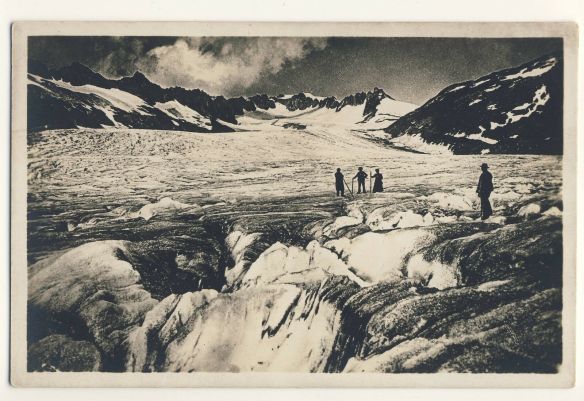
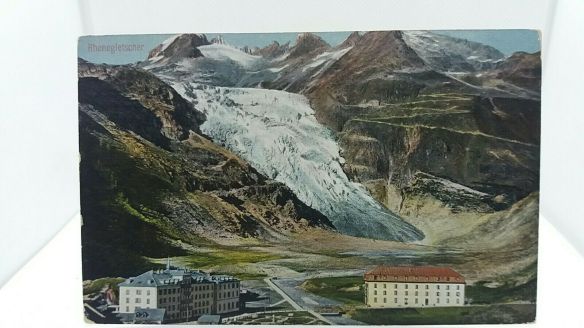
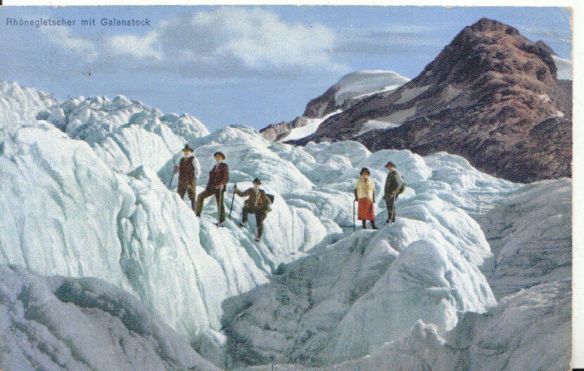
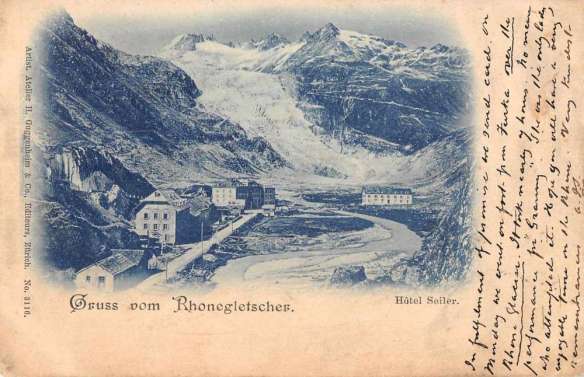
Some of the many hundreds of postcards of the Rhône Glacier easily found online. It was frightening and strange and grandiose, but easily accessible and so became a major tourist draw. This one’s from 1900.
And that’s where they have stayed. Over the last few years, the retreat of the glaciers (and of polar ice) under global warming has been uncontestable. It’s a staple of travel and eco-journalism, a certain grant winner in research institutes around the world. There’s more ice-tourism than our nineteenth century Romantics could have dreamt. There’s ice-art as well as the more obvious ice-science: the English research project Cape Farewell, for example, predicated on bringing boatloads of scientists and artists together to the North Atlantic, has helped to generate Rachel Whiteread’s memorable Embankment, seen in the giant Turbine Hall at the Bankside Tate, as well as chunks of pop songs, novels, sculpture and so on.
As ice gets rarer we seem to value it more. Ice – and more precisely the vanishing of ice – has become a bathetic disappointment on the global scale after the grandeur that we had got used to associating with it. It’s also a catalogue of threat – a visible measure of the extreme climate disaster that we humans have willed upon ourselves.
But the history has been very long. As early as the 1870s, scholars were measuring the glaciers as well as being awed by them. Even then, it was clear that climate cycles varied, and that there might be a human element in the acceleration of global warming.
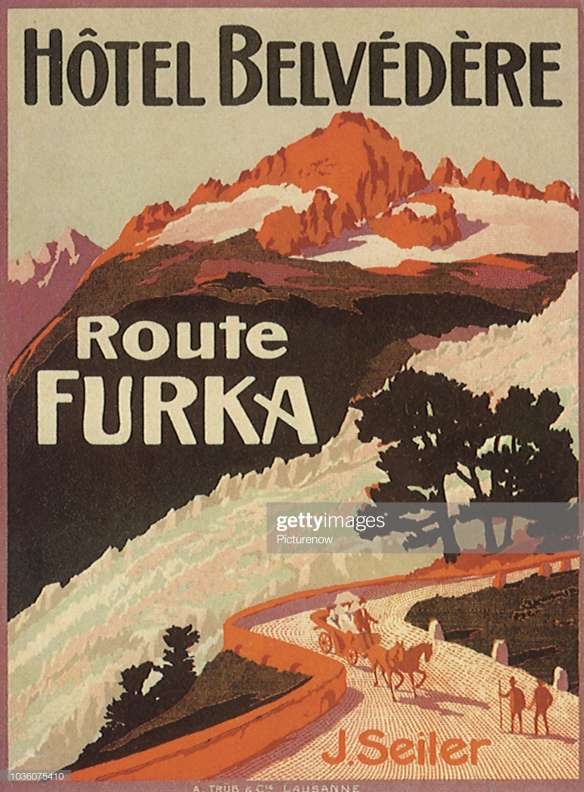
Luggage Label from the Belvedere Hotel. Photo credit Picturenow/Universal Images Group via Getty Images
There’s a hotel high on the Furka Pass called the Belvedere which was built specially to give access to that most touristic of glaciers. It was built by Josef Seiler and opened in 1882. Seiler knew about Alpine tourism; he was of that Seiler family which in effect built Zermatt, catering to and profiting from the English obsession with Alpinism.

Edward Whymper’s hut on the Matterhorn, engraved c1880. His first ascent was earlier and had involved his watching helpless as a substantial portion of his party slithered to their deaths after a rope parted on the descent from the summit. The English vision of Alpinism was widely regarded as eccentric in the Alpine nations for some years, although there was of course money to be made from it by hoteliers and others.
Seilers didn’t just build hotels. They invested in mountain railways to get people there, bought farms to feed them once they’d arrived, lobbied furiously for membership of town and regional councils. At the Belvedere, you could lean on the balcony of your room and look out over the glacier. Josef Seiler owned a hotel in Gletsch (the clue is in the name: it simply means Glacier) just down the road in the valley, to mop up any business of people looking up at the glacier from below. The Belvedere became famous.

The Belvedere is marked on the staircase of hairpins, with the ice still reaching far below it to the valley floor
So famous that Sean Connery as James Bond in his Aston Martin (rather sedately) chased Tania Mallett over the pass, right past the Belvedere, in the 1964 film Goldfinger. But the fame began to wane. Some say that as cars became more powerful, people could race through the Furka Pass in a day rather than lingering two or three. Others note that exoticism moved elsewhere and that Switzerland, even high Alpine Switzerland, was simply left behind as travellers moved further afield. And the main attraction was plainly not what it was. Year by year, the Rhône Glacier melted. It used to reach right down to the valley floor at Gletsch, but it retreated. Now it doesn’t even reach past the Belvedere, perched on the shoulder of the pass, and the glacier is now a lake in its own collecting bowl high above the steeper sides of the valley. The hotel is already closed, its future uncertain. Who wants to see a glacier that was once majestic?
One of the attractions had been the road itself. A perilous concatenation of hair-pin bends, it was a thrill seeker’s delight and the Seilers made sure the buses ran up there full of guests to fill their high-altitude beds. It still attracts large numbers of cyclists and its fair share of motor tourists. The whole marketing concept of the GT car – the Grand Tourer – is based on the seduction that a sufficiently comfortable car could take you touring over these passes like a pre-petrol grandee making the journey from Northern Europe to Italy on the old fashioned Grand Tour, cocooned in the smell of your leather seats and watching the view scroll in front of your comfortably insulated windshield. Many car advertisements have involved smoothly driving up roads like this: it’s what you’re supposed to imagine that you could do or will do when you’re actually stuck on the Périphérique or the M25 breathing in the fumes of the car in front.

The hairpins in 1911. Many of the images used in post-cards appear again and again. But sometimes they are datable – and that gives solid evidence for the level reached by the ice at different times.
Another of the attractions has long been a cave dug out of the ice to allow visitors to walk actually within the glacier. The tradition was started by Seiler as an unashamed tourist draw and continued by his successors. The idea is that the ice which looks so grey and rocky – grubby is the word – from outside refracts light in a special way and that for a few tens of metres you can walk in an ethereally cool blue grotto – an experience which still today raises oohs and aahs on Instagram. The glacier moves, so the grotto distorts through the season and has to be dug afresh every year. But recently the retreat of the ice has been so fast that special measures have had to be taken; the Carlen family, successors to the Seilers, who own a gift shop and in effect own a bit of the glacier, felt that their asset was simply melting away. The grotto which had been tens of feet below the surface of the ice, was now sometimes not even covered: more of a crevasse than a cave. They started ten or so years ago to protect their bit of ice by covering it with thick canvas lined with insulating materials, desperately trying to make a season’s attraction last a season. I repeat it, because it’s such an extraordinary idea. They tried, with all the help that money and science could give them, to keep a glacier cool. Nobody much has ever felt the need to do that before. Now we all fervently hope for exactly that.
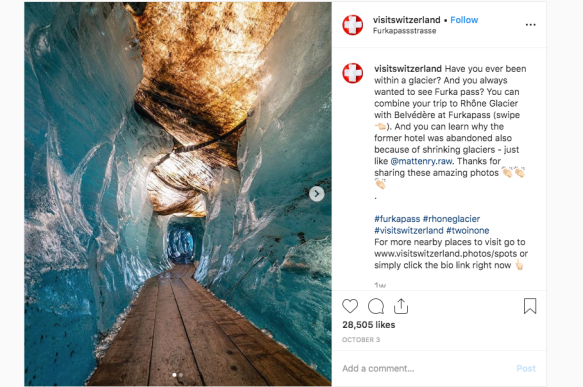
By the time modern tourists are there, the tunnel is so shallow the roof is made no longer made of ice : it’s a cloth covering. The tunnel is no longer a tunnel
But you can’t stop a process like global warming with a few blankets, even very expensive and high-tech blankets.
That’s the long story that Simon Norfolk and Klaus Thymann walked into when they started to be interested in the retreat of the Rhône Glacier and in making their Shroud series there. The original invitation, I think, was Thymann’s – his Project Pressure has Visualizing Climate Change as its strapline. They were no means alone in finding it a powerful story to photograph. A number of agency photographers had worked there. Thymann himself had invited other artists. And some of the Furka artists from nearly a generation before had been actively concerned with climate change, too. All of them work in the shadow of long lines of artists who have processed here to marvel. Caspar Wolff painted the glacier in 1778 as a vast Sphinx claw, narrow on the descent and then spreading down the valley. Through the nineteenth century there are watercolours, engravings, lithographs. John Singer Sargent came as a teenager, on the itinerant holidays of his American expatriate family, up from the heat of Florence in the summer of 1870. Later the postcard came to the glacier, along with the tourists, first by diligence and then by charabanc.
“I’ve always found being in the presence of a glacier most haunting,” said Norfolk when interviewed for the Unseen festival in Amsterdam recently. “Silent, withering, accusing. I’m 55 years old: my generation’s lifestyle burned away this ice. On a glacier, I always feel in some sense, guilty… The glacier seemed to be being wrapped in preparation for its own funeral. This Life/Death state-change interests me enormously. We photographed the shroud to resemble Carrara marble which traditionally in western art has been used by the greatest artists to turn a lifeless stone block into the flowing liveliness of Sculpture. The ice of a glacier is made of water but looks and feels like hard stone. With time and the power of the ice, the strongest rocks on earth are plastic, as carve-able as butter. This glacier, which has existed for millennia will die within the lifetime of children born today. None of the physics of my little, suburban life seem to be quite reliable when we get up there at high altitude, at greater pressure and at much, much longer timespans.”
Norfolk had worked with glaciers before, notably in an earlier partnership with Thymann, chronicling – by lines of fire – the erosion of the Lewis Glacier high on Mount Kenya. In that context, Norfolk had written
”To be next to the ice is to feel privileged: like you are beside a colossal, sleeping giant. I imagine being close to a darted bull-elephant feels the same and I’m reminded of 17th century Dutch paintings of awestruck, bewildered Burghers contemplating a stranded whalefish. Close-up one senses the glacier’s bulk, its coiled, dormant energy or its colossal longevity. And, of course, its cold, resigned indifference. One is hit by an overwhelming feeling of one’s own smallness and transience. Englishmen have been feeling this way about mountains for 300 years, since Romantic, Grand Tour travellers first astonished Swiss inn-keepers with the request for help in climbing to the heights. Nobody had done that before; for the fun of it, because it made you feel whole, because it feeds the soul. But this is the opposite – to think that in ten or twelve years this elegant, magnificent glacier will exist only in photographs is unbearable. The feeling I have for the losing of the Lewis can only be called grief.”
Norfolk’s work on Lewis is extraordinarily moving, and it won prizes. There are reasons for that. Norfolk knows grief and has thought deeply about it. He has been his whole career a photographer of the landscapes of grief. An early series was on the concentration camp at Auschwitz. Then Bosnia, Afghanistan, The Middle East .. He made a project (and called it For Most of it I Have No Words, a most exquisite title) on the landscapes of genocide. He has recently made a remarkable film on the nationalisation of death during and after the Great War, in the enormous cemeteries which made such a spectacle of public grief, but prevented individual families from bringing home their own loved ones. This is, in other words, an artist honed and practised in the elusive aura that one can find (or be painfully moved looking for) in places where death and dying have occurred on a huge scale. Planetary death – it’s an emotive expression, but one that is bandied around much more than it used to be – is maybe the natural extension of that work.
Thymann, too, had been well prepared for the glacier. An environmental photographer of great experience, he is a superbly experienced caver, mountaineer, diver.. He has often learnt those skills to get specific groups of pictures, when those skills were what it would take to get them. An explorer and expedition leader, notably at great altitudes or depths (he has worked on the underground rivers of the Yucatan, in Tonga, in Greenland..), he is also an investigative reporter, skilled at ferreting out truths. Those shrouds high on a mountain in the Valais were waiting for Thymann and Norfolk.
I’m neither very good at the technical processes behind photographs, nor (sometimes) very interested. Yet even I noticed straight away that Norfolk and Thymann’s views of the shrouded mountain held a peculiar quality of light. High in the mountains, where most photographers are happy to be wowed and wooed by the shifting qualities of cloud-dappling and storm-darkening, they thought the light wasn’t good enough. That’s amazing in itself. They weren’t prepared to ‘capture’ or ‘reproduce’ the scenes they saw. They were making something new up there, creating an artwork as surely as if they held burins or gouges in their hands. Anybody who thinks these photographers simply ‘took’ these pictures, and that he or we could do something roughly similar just by being up there in the cold misses the point entirely. Thymann and Norfolk certainly have much of the truth-teller about them. But they are also heirs of those Romantic landscapists. These may be campaigning pictures (and the New Scientist once reviewed them as such) but they are emphatically not documentary pictures. That in itself is new. It used to be that to call people to action in photography you were expected to show the wrong as it was. Yet here Norfolk and Thymann boldly show the glacier as a metaphor. Call the series an elegy, or a requiem, or a lament – the exact word hardly matters., but the mood is inescapable. The shrouded ice was there; but it’s wrong to imagine the pictures were all-but made and Norfolk and Thymann had merely to record them once they’d got there. These are great poetical views, the work of the hand and eye and brain of two fine artists working to bounce ideas off each other, as slanted and deliberate as anything the Romantics produced in front of that same glacier.
I’ve had these picture on my computer some time. And they stay in my eye, echoing all the time. That somebody is wrapping glaciers to eke out the last tourist money before they disappear is not a big deal at all. That someone else has been up there and found it a symbol for the absurd losers’ gambling that we are all playing with climate change and our environment is different. This is on a par with Shelley in Chamonix – although because it’s done in photographs, no-one will ever find the comparison tolerable. It is no exaggeration. Norfolk, sharpened in his hard craft, with years of treading gingerly over bodies to his account, and assured as only an experienced person can be in his long view, is at the height of his powers here, making photographs whose every echo and chime he takes full responsibility for. Thymann has found the great story his years of exploration prepared him to tell. You are moved looking at these pictures precisely as two photographers working together wished you to be moved.
The light, it turns out, is due to a fancy helium balloon they bought, which allowed them to suspend lights in the middle of the scene, in the manner of a lighting-director choosing how to light an opera. The balloon was not that easy to control, and involved large challenges of its own. Where most artificial light trespasses in on a view from the sides and edges, the balloon allowed Thymann and Norfolk to drop light from above – an idea which is metaphorically apt just as it is physically appropriate. The glacier is melting, after all, at its furiously accelerated pace, partly because more of that light from above is getting through to it.
The doctoral research of a scholar called Meredith Kelly was to make sense of the many little marks and scars of evidence which told her something of the ancient history of the Rhône Glacier. She looked for the tell-tales of the presence and movement of glacier ice in the past: moraines, which mark where the ice stopped; trimlines, which show how high it reached (the rock is polished by ice below the trimline; more roughly eroded by weather only above); rat-tails, which are thin lines of bed rock, sometimes only a few inches long, left un-eroded by ice because they lay in the lee of something hard such as granite. She also looked for roches moutonneées – bedrock hills that were rounded and polished by ice. All of these made to Kelly a clear picture. Twenty thousand years ago, the Rhône Glacier was a dome of ice ninety-six hundred feet high, part of a sea of ice that covered the whole of this part of Switzerland, with only a few isolated crags poking up above it. That sea flowed in a number of directions away from its cap. Standing next to the waterfall at the edge of the present glacier, you would have been under a mile or more of ice.
It’s a deeply disturbing scene up there. The sheer futility of those blankets is one thing. They do, in fact provide a measure of insulation. But they provide it over a tiny area – just enough to remind of us of all the other hundreds of thousands of acres of glacier around the world where no such protection has been put in place. Covers or no, the glacier is shallower, shorter, narrower than ever before. The tarpaulins can’t resist the weather very well anyway – we can see how they have torn and frayed in the winds. If the tunnel has to be dug again every year as the ice shifts, each time slightly further away from the Belvedere hotel, each time slightly shallower as the glacier’s depth diminishes, so it seems the blankets have to be renewed as well. We’re beginning to see something of the vertiginous inadequacy of any of these man-made measures to preserve and protect. Deep, deep down in the crevasses of global warming, itself man-made of course, tiny figures are toiling away to effect change. It won’t work; it can’t work. Yet it has to work. To see the little figures start to try it is to be moved.
Simon Norfolk’s work is sometimes referred to in the jargon as ‘aftermath’ photography. He is not, the implication is, a war photographer, but somebody who arrives soon after the front has moved on, and looks at the shattered remains left behind. The duckboards that make the path into the glacier bring to mind the trenches of the First War, horrible walkways that allowed troops to wander an inch or two above the muddy, shitty swamp in the bottom of each trench, often picking their way past the bodies of their mates. Here, the tourists in boots and parkas (themselves derived from military gear) pick their way for a few Swiss Francs into the heart of the wounded glacier without even having to get their feet cold. I recalled earlier Norfolk speaking of Carrara marble in their vision of the Shrouds, and the allusion is fully there. But so is a curious vision of more malleable materials. The ice is unstable in many ways. Glaciers move at their inexorable pace, down the hill. The ice within them cracks and splits and bits of it hurry away from other slower parts. It’s melting all the time, too. Add the classical fluid drapery of the shroud, pleated and arranged like the clothes on sculpture of long-gone saints; and add the other bits of shroud, torn and worn like old burial cloths or bandages and you have a vision more mobile than marble, less stable. It’s more like terracotta, infinitely malleable until its stilled in the curves and planes the photograph holds on to. People talk of pictures freezing the scene; but here, though the scene is moving all the time, the photograph isn’t cold enough to freeze it. This is aftermath photography all right. We may well be looking at the aftermath of the Anthropocene, the era when the planet was marked by the agency of Man. We’re certainly looking at a wreck of glacier, beautifully swaddled for death.
